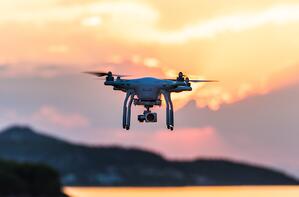 A thermal image camera with broadcasting capabilities can be mounted on a fire fighting drone. This drastically improve both effectiveness of putting out the fire and the safety of the fire crew, as the drone can be used to locate fires and fire hotspots within large tower or complex buildings.
A thermal image camera with broadcasting capabilities can be mounted on a fire fighting drone. This drastically improve both effectiveness of putting out the fire and the safety of the fire crew, as the drone can be used to locate fires and fire hotspots within large tower or complex buildings.
A good example is the agreement between North Wales Police with the Fire Brigade. This agreement means the fire service can call on the police drone pilots to help them deal with incidents when needed.
North Wales Police's Deputy Chief Constable Gareth Pritchard added the drones were a highly cost effective tool in fighting crime and helping communities.
"Being able to launch a drone in the air in a few minutes could help save lives and secure vital evidence if a crime was in progress," he said.[1]
Both the fire service and police force benefit from joint drone agreement: Escaped suspects have fewer places to hide when the police have a live-steamed aerial view to help them track and follow / pursuit. Stuart Millington, of North Wales Fire and Rescue Service, said the ability to see aerial moving images that show fire hotspots was a "significantly useful tool" in on going incidents.
Finding missing people
The mountain rescue teams waste many man-hours walking and searching for missing people. Helicopters expedite the search, especially in poor weather. Search and rescue costs escalate when helicopters are used. Understandably, the high costs render it probative for some regions, especially in countries where the activities are funded by charitable donations. Drones with live streaming of footage, allow searches to be expedited. Drones used in this situation can reduce scatter approach searching and let the mobile teams hone in quicker on the missing or injured person. Using multiple helicopters to search different areas is cost-prohibitive, but it’s possible with drones.
The drones can also be used to track tagged people with personal transmitters, who are known to have mental health problems (such as Alzheimer) and who have a tendency to wander off and get lost.
There are normally time delays in sourcing and securing an available helicopter and crew. With a drone, the local team can start searching within minutes of arriving at the scene. It saves precious time when risks like hypothermia are possible.
The Devon and Cornwall Police use drones [2]
Chief Superintendent Jim Nye, who leads the new unit, hopes the team will be able to shape how other forces used drone technology in the future.
"The helicopter isn't always available and you want to have it available for life-threatening situations," he said. "I think the public would expect that if we can get value for money with a drone over a helicopter, that we do."
Integrating drones within IT eco-system
Accurately knowing where the drone is flying, can be combined with superimposing the inbuilt GPS over a digital map. This allows broadcasting of images with location for further integration into you IT eco-systems. This could for example integrate with location of staff and resources.
Visual recognition
Your IT eco-systems could also be linked with visual recognition tools. European police forces aren’t capturing the full potential of facial recognition software. By broadcasting HD images from the drone, you can use facial recognition software to identify missing people, suspects, or criminals… The flexible location of the drone is enhanced by these linked technologies and it also improves the efficiency and scope of your workforce’s abilities.
Thermal imagery to hunt cannabis farms
Thermal imagery can be used by police and fire departments issued with specialised phones with 2 cameras (thermal and daylight). Soliton’s app on the phone can stream the images back to the command centre. This allows live reporting on situations involving fires, unknown locations and assailants.
It also enables the police to cost-effectively search areas for illegal cannabis farms inside. With a thermal camera it’s easy to see which rooms have been kitted out with ultra-insulation and heat reflectors. They light up beautifully on the thermal images.
This drone-gathered knowledge reduces the time-intensive knocking on doors and provides targeted house-searching list. Knowing where the drone is flying, can be combined with superimposing the inbuilt GPS accurately over a digital map. Then a map with all suspicious locations can be provided to the ground force. Their hit rate will be massively improved.
[1]Source: http://www.bbc.com/news/uk-wales-42636797
[2]Source: http://www.bbc.com/news/uk-england-devon-40595540
Do you want to read more about Soliton's drone solutions? Broadcast quality live video streaming from drones




